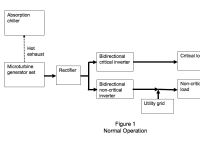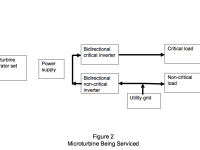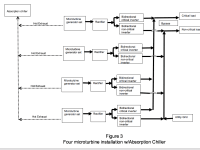
Dual-inverter Precise Power System
Over 8,500 Capstone microturbine generator sets are currently in service. Twelve have been providing continuous precise power to the Syracuse University data center since 2009. As the electricity consumed by the data center becomes heat, substantial cooling is needed. This is provided by absorption chillers using the hot turbine exhaust as their energy source. The microturbine provides both electrical and thermal energy, so efficiency is very high.
If the system was very small, it could use a single microturbine. The high-speed generator would produce high frequency power. This would be rectified and inverted back to the voltage and frequency required by the computers. The single microturbine would run at part load to match computer load. However, this is less efficient than full load and does not use the full capacity of the microturbine.
The microturbine should run continuously at full power and use two inverters. The first or critical inverter provides precise power to the computer and follows the load. The second or non-critical inverter is paralleled with the grid reducing the amount of power purchased from the utility (Figure 1). As the computer load varies, the non-critical inverter varies inversely. So microturbine output is constant and all is used beneficially. Step loads are easily handled.
The hot exhaust can be used directly or with an intermediary hot water or steam boiler to produce cooling in an absorption chiller. This is standard procedure for thousands of microturbines used in combined heat and power systems. But cooling is mandatory for computers and this cooling comes with essentially no additional energy consumption.
Reliability and availability would be high. The microturbine has just one major moving part – the compressor/turbine/generator rotor. It runs on air bearings so no lubrication or oil changes are needed. Most microturbines burn natural gas but can switch to propane without shutting down and with no voltage or frequency perturbations. They can also run on diesel. Scheduled service requiring a brief shutdown is once per year.
If the grid goes down, it is disconnected and the microturbine provides continuous precise power to the computer. If the microturbine goes down, the grid provides power to the computer through the two inverters which are bidirectional (Figure 2). Batteries can float on the dc bus to handle brief irregularities. A backup heat source for the absorption chiller can be provided.
The probability of both the grid and the microturbine failing simultaneously is slim. But where extremely high reliability is needed, redundant units can be added (Figure 3). Extra microturbines can also be added at any time to increase capacity.
The system is cost effective. Massive battery banks and standby generators capable of handling a conventional UPS and conventional chillers are unnecessary. Energy cost is low. The full capacity of the microturbines is used beneficially, the microturbines operate at their most efficient point, and the chiller energy comes from normally wasted exhaust heat.
U.S. Patent 6,977,446 is applicable.
-
Awards
-
 2016 Top 100 Entries
2016 Top 100 Entries
Like this entry?
-
About the Entrant
- Name:Robin Mackay
- Type of entry:individual
- Patent status:patented








